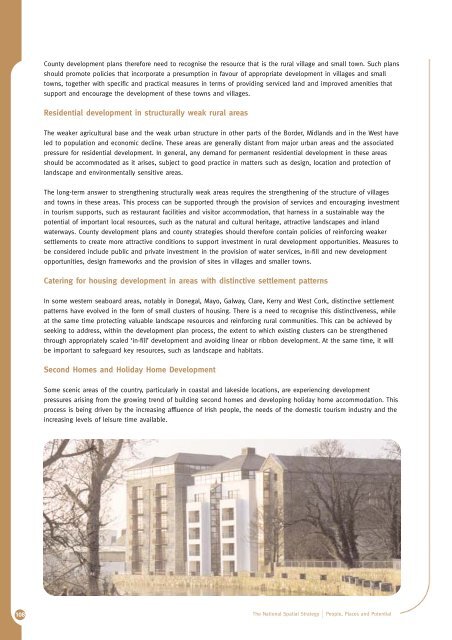National Spatial Strategy For Ireland 2002 - 2020 - Full ... - Kildare.ie
National Spatial Strategy For Ireland 2002 - 2020 - Full ... - Kildare.ie
National Spatial Strategy For Ireland 2002 - 2020 - Full ... - Kildare.ie
Create successful ePaper yourself
Turn your PDF publications into a flip-book with our unique Google optimized e-Paper software.
108<br />
County development plans therefore need to recognise the resource that is the rural village and small town. Such plans<br />
should promote polic<strong>ie</strong>s that incorporate a presumption in favour of appropriate development in villages and small<br />
towns, together with specific and practical measures in terms of providing serviced land and improved amenit<strong>ie</strong>s that<br />
support and encourage the development of these towns and villages.<br />
Residential development in structurally weak rural areas<br />
The weaker agricultural base and the weak urban structure in other parts of the Border, Midlands and in the West have<br />
led to population and economic decline. These areas are generally distant from major urban areas and the associated<br />
pressure for residential development. In general, any demand for permanent residential development in these areas<br />
should be accommodated as it arises, subject to good practice in matters such as design, location and protection of<br />
landscape and environmentally sensitive areas.<br />
The long-term answer to strengthening structurally weak areas requires the strengthening of the structure of villages<br />
and towns in these areas. This process can be supported through the provision of services and encouraging investment<br />
in tourism supports, such as restaurant facilit<strong>ie</strong>s and visitor accommodation, that harness in a sustainable way the<br />
potential of important local resources, such as the natural and cultural heritage, attractive landscapes and inland<br />
waterways. County development plans and county strateg<strong>ie</strong>s should therefore contain polic<strong>ie</strong>s of reinforcing weaker<br />
settlements to create more attractive conditions to support investment in rural development opportunit<strong>ie</strong>s. Measures to<br />
be considered include public and private investment in the provision of water services, in-fill and new development<br />
opportunit<strong>ie</strong>s, design frameworks and the provision of sites in villages and smaller towns.<br />
Catering for housing development in areas with distinctive settlement patterns<br />
In some western seaboard areas, notably in Donegal, Mayo, Galway, Clare, Kerry and West Cork, distinctive settlement<br />
patterns have evolved in the form of small clusters of housing. There is a need to recognise this distinctiveness, while<br />
at the same time protecting valuable landscape resources and reinforcing rural communit<strong>ie</strong>s. This can be ach<strong>ie</strong>ved by<br />
seeking to address, within the development plan process, the extent to which existing clusters can be strengthened<br />
through appropriately scaled ‘in-fill’ development and avoiding linear or ribbon development. At the same time, it will<br />
be important to safeguard key resources, such as landscape and habitats.<br />
Second Homes and Holiday Home Development<br />
Some scenic areas of the country, particularly in coastal and lakeside locations, are exper<strong>ie</strong>ncing development<br />
pressures arising from the growing trend of building second homes and developing holiday home accommodation. This<br />
process is being driven by the increasing affluence of Irish people, the needs of the domestic tourism industry and the<br />
increasing levels of leisure time available.<br />
The <strong>National</strong> <strong>Spatial</strong> <strong>Strategy</strong> | People, Places and Potential
















